Why is the keris bengkang bengkok? Here’s a history of the keris we never knew

- 1.8KShares
- Facebook1.6K
- Twitter37
- LinkedIn9
- Email74
- WhatsApp130
[This article was originally written in BM. Untuk membaca artikel dalam BM, sila klik sini.]
Mention the keris and what comes to mind? Is it…

Orrrrr this?
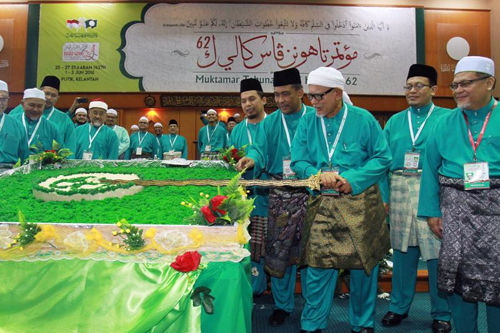
Or maybe you have the same thoughts about this mysterious wavy dagger (although there are straight blades as well) as the rest of the rakyat. We asked them on Facebook and these were pretty much their answers:
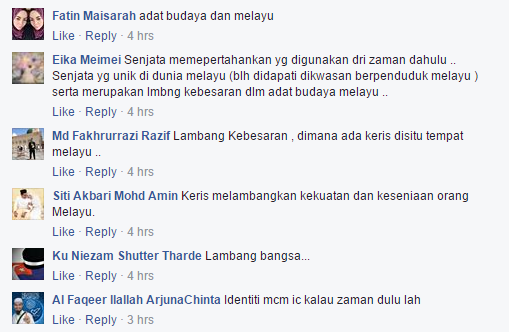
The keris is a short-based weapon of Austronesian origin. It is used as a weapon for self-defense, as well as a symbol for royalty. The Austronesians are populations of people found around the regions of Oceania and Southeast Asia and (oddly enough) Taiwan. It is widely believed that Malaysian Malays – and Indonesians, Filipinos, Brunei etc. – descended from Austronesians.
So, we know today that the keris is uniquely ours because it is only found within the Malay Archipelago. Not in the Swiss Alps, not at Stonehenge… So where exactly did historians find the keris? And when exactly were they first made?
The oldest keris was found at Borobudur temple in Indonesia
There are a lot of theories as to the origins of the keris. Some believe it might have come from India, and others believe that was possibly inspired from a Vietnamese weapon. But so far the earliest record of the keris was discovered at the Borobudur temple in Central Java, Indonesia, made in approximately 600BC.
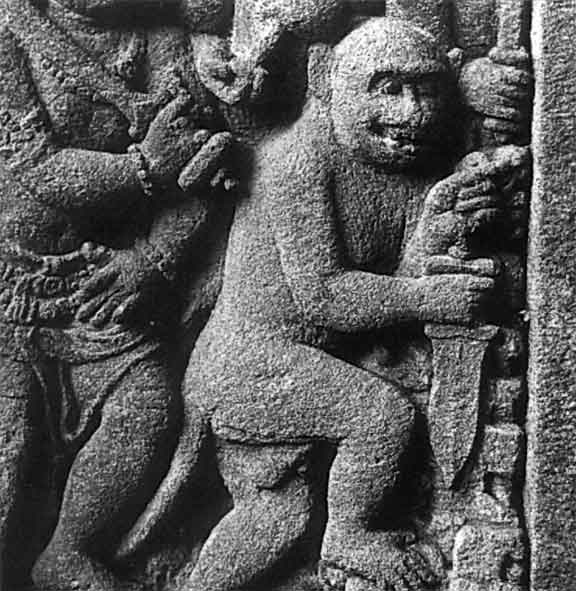

As for the modern keris that we know of today, it is believed the oldest one discovered is the Keris of Knaud. The date 1264 is inscribed on its iron blade (which correspondends to 1342 AD). Scientists suspect that due to its special features the dagger could be even older. It was given to a Dutch physician Charles Knaud by Paku Alam V, ruler of the Pakualaman principality in Yogyakarta.
According to a documentary from Discovery Network, the metal used to craft the first kerises were made from molten lava! And by that we mean the volcano kind, not the chocolate cake kind. Other theories say that the early kerises were possibly made from rare meteorite iron that “fell from the heavens”, symbolising “union between man and God”. Whoooahhh, meteorite iron?! Bet even Superman is still on the waiting list to buy one.
What about the origins of the WORD ‘keris’? Well, one theory claims that the word ‘keris’ originated from the Javanese word ‘ngeris’, which translates to ‘stab’ or ‘prick’.
We found a blog where the writer claimed that when he visited the Muzium Adat Istana Jahar in Kelantan, the Jawi alphabet of the word keris (Kaf, Ra, Ya, dan Sin) has meaning of its own. They mean: Ketahanan Rakyat Yang Sepadu, Kekuatan Raja Yang Sejati, Keamanan Rakyat Yang Sejahtera, Kemuliaan Raja Yang Susila, Kebanggaan Rakyat Yang Setia, dan Kuasa Raja Yang Sejagat.
(Very loosely translated in English: Endurance of a united people, the power of true kings, peace of a prosperous people, honor of noble kings, the pride of loyal subjects, and the power of universal kings…..like we said, very loosely translated).
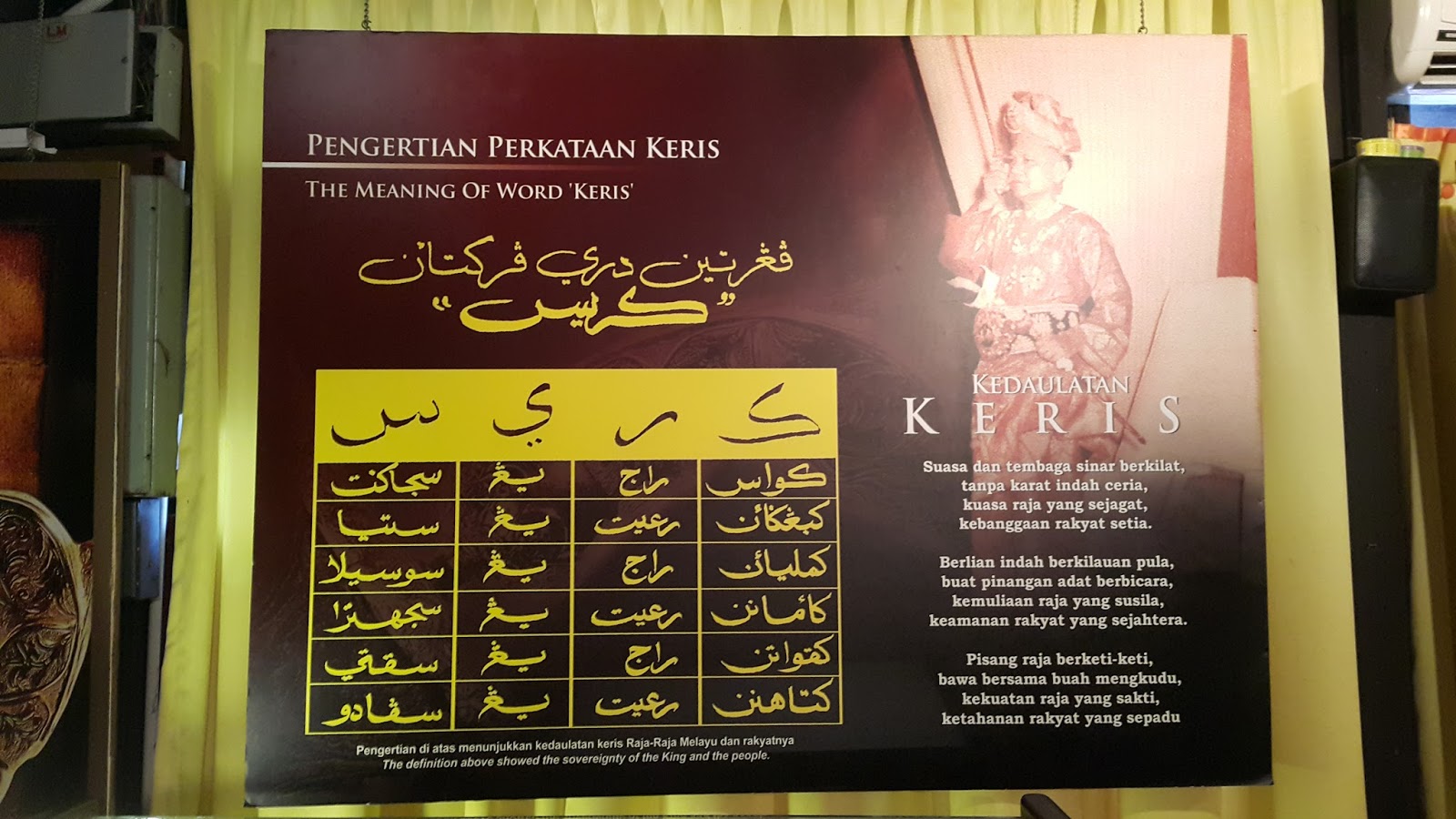
But why is the keris wavy?
Now before we answer this question, let’s get the know the anatomy of the keris. It’s a lot more complex than we thought, however we’re gonna simplify it into its three main parts – blade (wilah), hilt (hulu) and sheath (warangka). In a record about Admiral Zheng He‘s expedition (we know him as Laksamana Cheng Ho in our Sejarah textbooks), it is described:
“All men in Majapahit, from the king to commoners, from a boy aged three to elders, slipped pu-la-t’ou (or more precisely keris dagger) in their belts. The daggers are made entirely of steel with intricate motifs smoothly drawn. The handles are made of gold, rhino’s horn or ivory carved with a depiction of human or demon; the carving works are exquisite and skillfully made.”
Hilt (the part where you hold the keris)
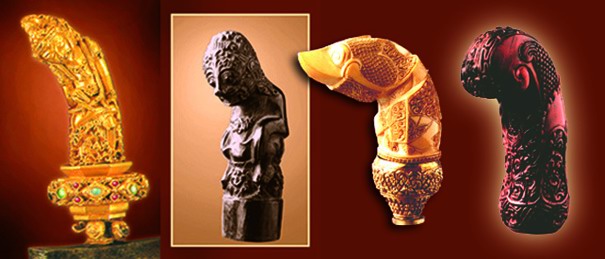
The shapes of keris hilts signify its strength and power, and they’re usually made from wood, gold, silver or ivory (ie. elephant tusks). Sometimes they would be embellished with precious stones too (such as rubies), and they’re often carved to resemble Hindu deities.
Blade (the sharp, wavy part that you use to cucuk people)
For those of you wondering why the blade is bengkang bengkok, historians say that it’s not used to cut things like a knife or a sword, but to STAB. The motions of cutting and stabbing are different. There are sources that add the wavy shape is to symbolise a snake ready to attack. These waves are called ‘lok’. The number of lok on a keris is always an odd number because it matches with Islamic traits (like the rukun Islam [5], rukun sembahyang [13] and so on).
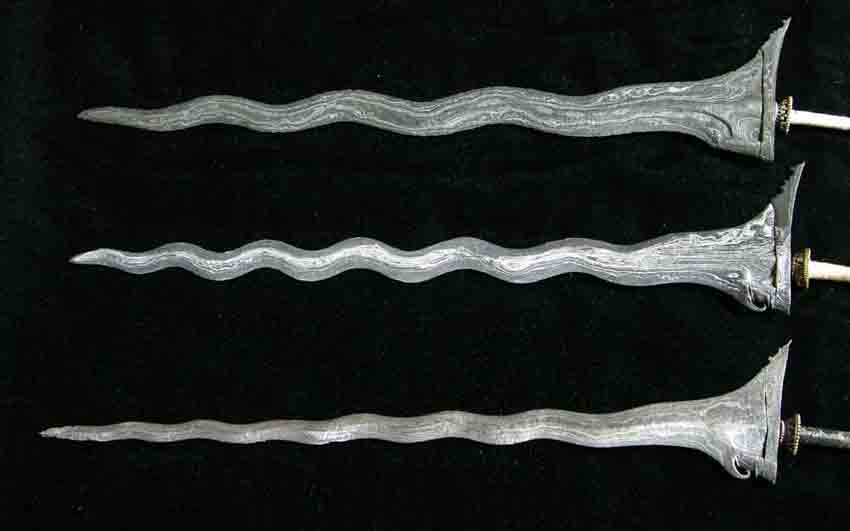
UPDATE [25/10/2016]: A couple of our readers also pointed out that the curves cause greater damage than straight blades when stabbing and pulling it out.
Actually, there are many straight kerises too.
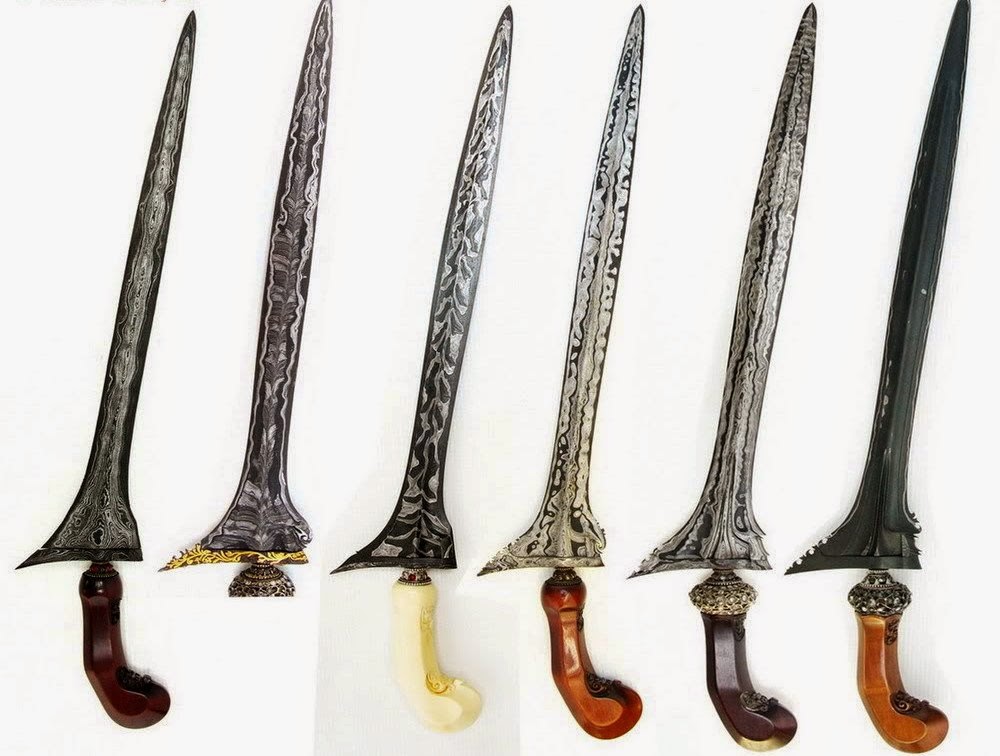
Some also believe that the number of lok on a keris is an odd number because it depicts imperfection, whereas only God is perfect.
“A master craftsman makes an even number of lok when its his last keris, signifying that he no longer wants to make keris and that this last one is the finest keris he has ever made.” – Professor Madya Dr. Abdul Mua’ti @ Zamri Ahmad, Dean of Modern Language and Communication Faculty, Universiti Putra Malaysia (UPM), quoted on Harian Metro
Sheath (the keris case)
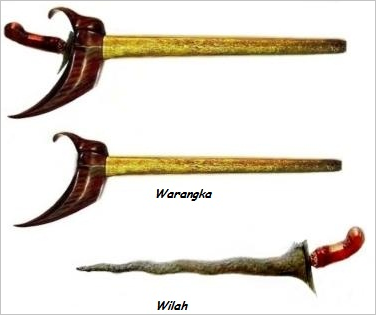
Just like the hilt, a keris’ sheath is also artistic. It is the outer casing which contains the blade when the keris is not in use. A sheath can be made from various materials, usually a wooden frame to hold the blade, which can be coated with metals (brass, iron, silver, or even gold etc.) and with floral motifs carved into it. The upper part of the sheath forms a broad curved handle made from wood or ivory, embellished with jewels.
The keris is also the emblem of greatness and sovereignty
Other than using it to stab one’s enemies, the keris is an emblem of Malay sovereignty and is always used during royal functions. The Keris Panjang Diraja is the greatest and most important one in Malaysia, used during coronations.
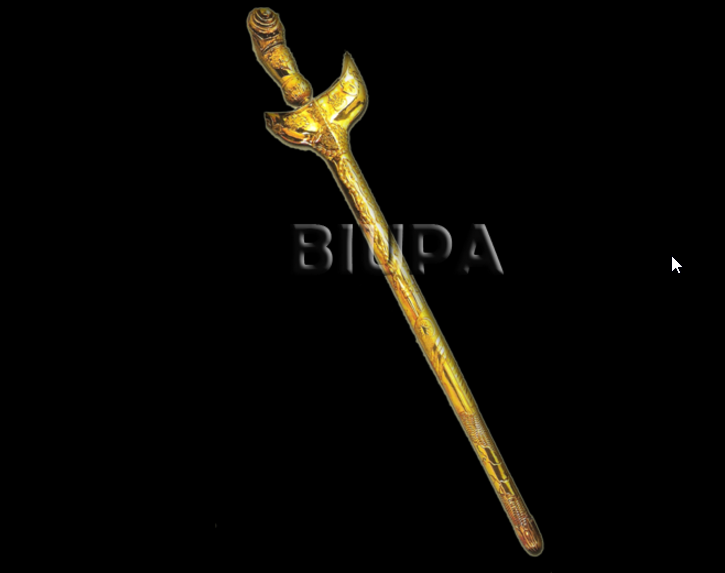
FYI, from the hilt to the sheath, this royal keris is plated with gold and on its side there is the Kerajaan Persekutuan emblem, as well as 11 state emblems. It can only be used by the Yang di-Pertuan Agong for certain ceremonies only.
WOW if the Keris Panjang Diraja is today’s symbol of power and royalty, what about the most legendary keris of all time….Taming Sari?
Taming Sari belonged to the legendary warrior Hang Tuah and supposedly made him invincible
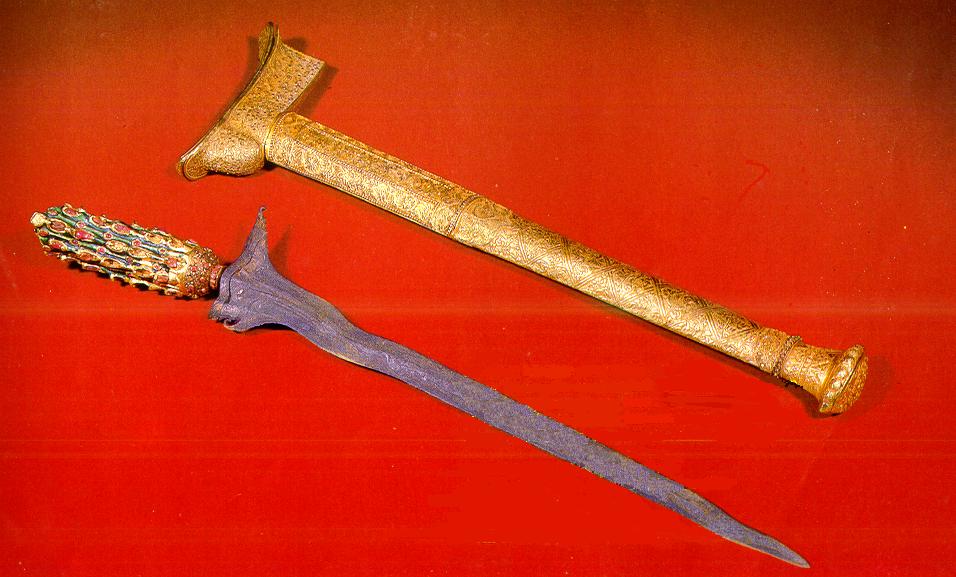
If you remember the story of Taming Sari, it belonged to the Malaccan warrior Hang Tuah and it was even fabled to grant its wielder invincibility. On one visit to Majapahit, Hang Tuah fought a duel with the famed warrior Taming Sari. Hang Tuah won and the ruler of Majapahit bestowed upon him Taming Sari’s keris as a reward. According to Discovery Network, the keris is reputedly made from 20 types of metals.
Remember the legend of Hang Tuah? He was accused of wrongdoing by jealous rivals and without properly investigating, Sultan Mansur Shah sentenced him to death. Taming Sari (the keris) was then given to Hang Jebat. When Jebat found out that his best friend Hang Tuah was sentenced by the Sultan and thought he was dead, Jebat led a rebellion in the palace until the Sultan fled to save his skin.
When the Sultan learned that Hang Tuah was actually still alive, he commanded the warrior to kill Jebat and wrest the Taming Sari from him. Because Hang Tuah was loyal to the Sultan, he obeyed the command and killed Jebat.
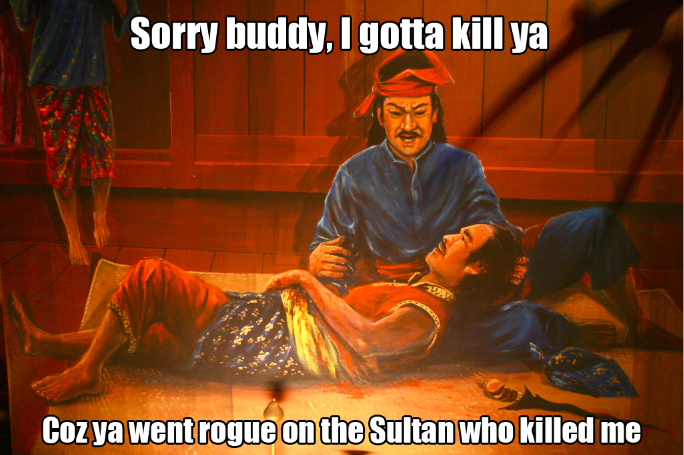
But where is the Taming Sari keris today? Some claim that it has been lost at sea, however what we found is…
“The Perak Sultanate believe that they’ve inherited Taming Sari, even though the Hang Tuah legend had written that the keris was lost at sea. This is because the Perak Sultanate had close ties to the Malacca Sultanate.” – Professor Datuk Zainal, Universiti Malaya (UM), quoted on Discovery Network
According to Kosmo, Taming Sari is well guarded in Istana Iskandariah, Kuala Kangsar, Perak. It is kept alongside 26 other items of royalty in a special safe in the palace.
“The keris had officially become the Perak Sultanate’s property since 1528, after it was left as an inheritance by Sultan Mahmud Shah I of Malacca to the first Sultan of Perak, Sultan Mudzaffar Shah.” – Nor Jannati Ibrahim, former Director of the Perak Museum, quoted on Kosmo
Taming Sari is said to still retain its ‘powers’, and this is taken very seriously at the museum, where the guard has to follow all the pantang larang while guarding it or carrying it.
And then there’s the mystical aspect of kerises…
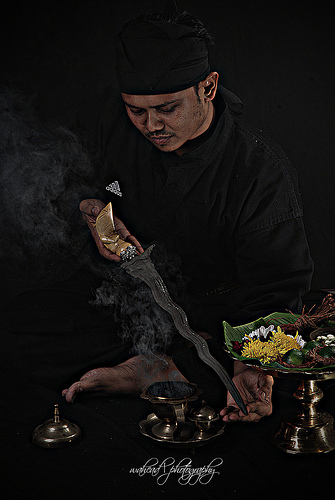
There are beliefs that the keris has its own spirit. In fact, according to old Malay tradition, it must be washed in limau and held over incense smoke, especially on Friday nights. Discovery Network mentions that kerises are cleaned in that ritual to protect it from rust.
“There are some people from the younger generation who are afraid of the keris, because they think that its has spirits, but this isn’t true and it’s completely unreasonable.” – Professor Madya Dr. Abdul Mua’ti in Harian Metro
However it can’t be denied that there are some owners or keris craftsmen who masukkan a penunggu (like a spirit) in the dagger to give ‘power’ to the wielder. This video of a dancing keris is sure to give you da creeps:
“Some families tied their heirloom kerises to the middle pillar of their house as protection for the family. But nowadays people consider it superstition.” – Professor Datuk Zainal, quoted on Discovery Network
Yet, some people do describe kerises as having a strong psychological effect on life, beliefs and daily habits. Because these thoughts are ingrained in their heads, they treat a keris like it’s sacred and respect it to the point of idolising it. This mindset still exists in the Malaysian community to this day.
Actually there might be a village in Terengganu where craftsmen still make the keris
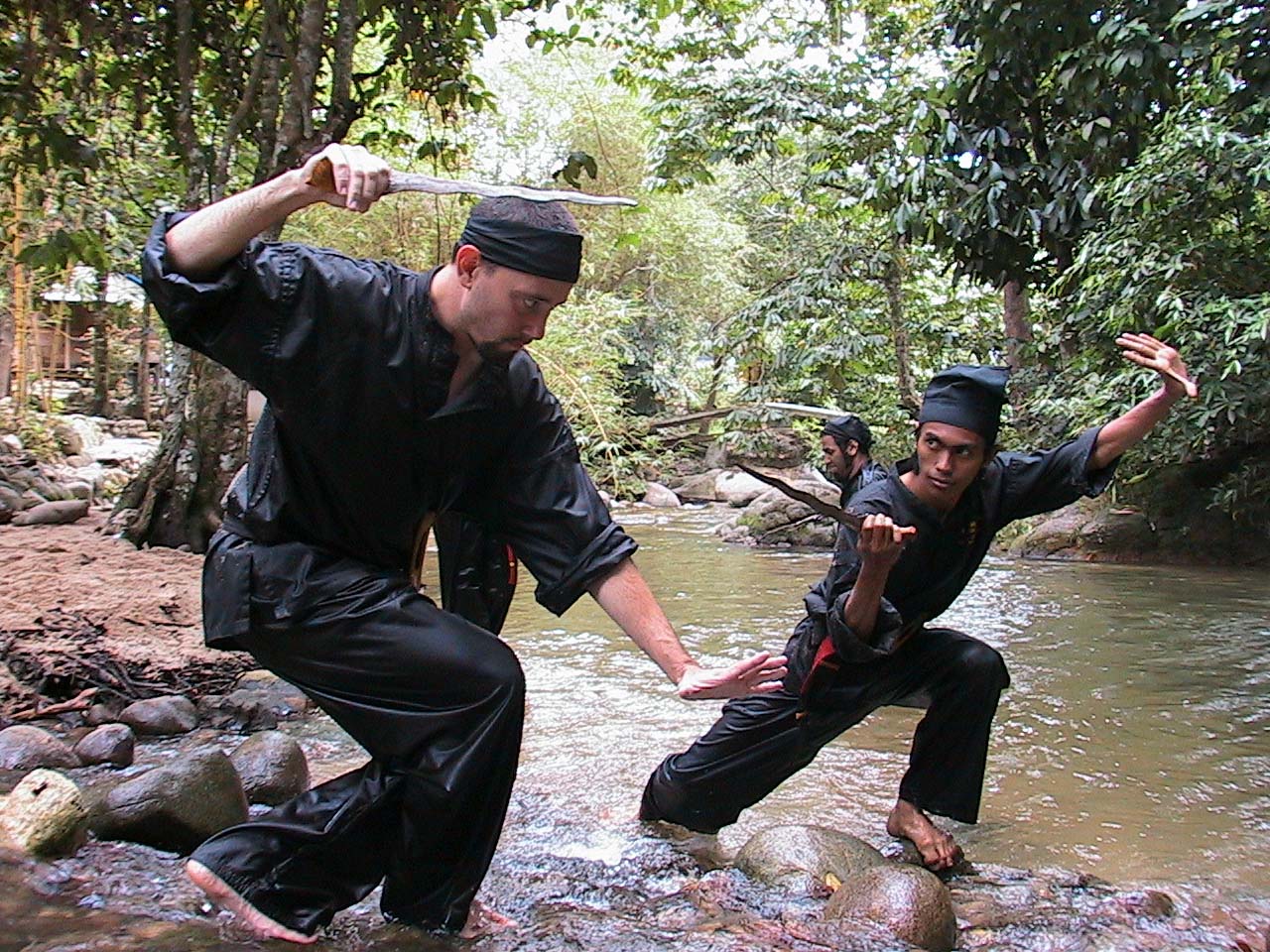
The art of keris making is slowly dying in Malaysia. Elderly keris craftsmen stay in smaller towns, but you could visit Kampung Ladang Titian in Kuala Terengganu, where there’s a keris-making centre. The village has the craftsmen – pandai besi (blacksmith) and sheath and hilt makers – needed to make a keris. Utusan once wrote a story about a certain Pak El from this kampung who still does this craft after his father passed the knowledge on to him. You can watch them transform ordinary iron and wood into a keris, and you may even have a chance to buy it.
Who knew there are so many sides to the keris culture in Malaysia, right? It is a weapon to protect oneself, it is a symbol of Malaysian royalty and sovereignty, in modern times, it is also seen as a collectors’ item. Although we obviously don’t and can’t use the keris as a weapon any more, it’s still something of a tradition and an identity in Malaysia.
- 1.8KShares
- Facebook1.6K
- Twitter37
- LinkedIn9
- Email74
- WhatsApp130



